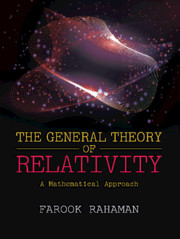Book contents
- Frontmatter
- Dedication
- Contents
- List of Figures
- List of Tables
- Preface
- Acknowledgments
- Chapter 1 Tensor Calculus — A Brief Overview
- Chapter 2 Geodesic
- Chapter 3 Einstein Field Equations
- Chapter 4 Linearized Gravity
- Chapter 5 Lie Derivatives and Killing’s Equation
- Chapter 6 Spacetimes of Spherically Symmetric Distribution of Matter and Black Holes
- Chapter 7 Particle and Photon Orbits in the Schwarzschild Spacetime
- Chapter 8 Causal Structure of Spacetime
- Chapter 9 Exact Solutions of Einstein Equations and Their Causal Structures
- Chapter 10 Rotating Black Holes
- Chapter 11 Elementary Cosmology
- Chapter 12 Elementary Astrophysics
- Appendix A Extrinsic Curvature or Second Fundamental Form
- Appendix B Lagrangian Formulation of General Relativity
- Appendix C 3+1 Decomposition
- Bibliography
- Index
Chapter 2 - Geodesic
Published online by Cambridge University Press: 24 March 2021
- Frontmatter
- Dedication
- Contents
- List of Figures
- List of Tables
- Preface
- Acknowledgments
- Chapter 1 Tensor Calculus — A Brief Overview
- Chapter 2 Geodesic
- Chapter 3 Einstein Field Equations
- Chapter 4 Linearized Gravity
- Chapter 5 Lie Derivatives and Killing’s Equation
- Chapter 6 Spacetimes of Spherically Symmetric Distribution of Matter and Black Holes
- Chapter 7 Particle and Photon Orbits in the Schwarzschild Spacetime
- Chapter 8 Causal Structure of Spacetime
- Chapter 9 Exact Solutions of Einstein Equations and Their Causal Structures
- Chapter 10 Rotating Black Holes
- Chapter 11 Elementary Cosmology
- Chapter 12 Elementary Astrophysics
- Appendix A Extrinsic Curvature or Second Fundamental Form
- Appendix B Lagrangian Formulation of General Relativity
- Appendix C 3+1 Decomposition
- Bibliography
- Index
Summary
Geodesics Equation
According to general theory of relativity, gravitation is not a force but a property of spacetime geometry. A test particle and light move in response to the geometry of the spacetime. Actually, curved spacetimes of general relativity are explored by reviewing the nature of the motion of freely falling particles and light through them. Freely falling particles are those particles that are free from any effects except curvature of spacetime. This chapter provides the derivation of the equations of motion of the test particles and light rays in a general curved spacetime.
The path or the differential equation of the curve having an external length, i.e., path of extremum distance between two points is called the geodesic equation.
Therefore, for a geodesic must be extremum, where the limits of integration are taken to be two fixed points A and B.
Thus,
For Riemannian space
Here,
is known as Lagrangian.
This implies Euler–Lagrange equation as
Here, p = affine parameter, describing the trajectory.
[In general, dτ(proper time) is proportional to dp, such that for a material particle, we can normalize p so that p = τ. Nevertheless, for a photon, the proportionality constant vanishes (as ds = 0, for photon)]
We can describe the geodesic line between two fixed points A and B. Let us consider the shortest path, i.e., the curve C is the geodesic line. The other two curves C′ and C′′, e.g., are different curves, other than geodesic C, with a variation δxμ (see Fig. 5). The geodesic line is described by xμ = xμ(s) = xμ(p), where s and p are parameters along the curve. The metric is defined as ds2 = gμ𝜈 dxμdx𝜈. The tangent vector to the curve xα = xα(s) at P is the unit vector. A and B are two fixed points.
Derivation of Euler–Lagrange Equation
We prove Euler–Lagrange equation from Eq. (2.1)
We can write the second term of (2.4) as the difference of two terms
The first expression yields zero after integration as the variations vanish at the end points of the curve. Thus, Eq. (2.4) can be written in the form
- Type
- Chapter
- Information
- The General Theory of RelativityA Mathematical Approach, pp. 45 - 60Publisher: Cambridge University PressPrint publication year: 2021



